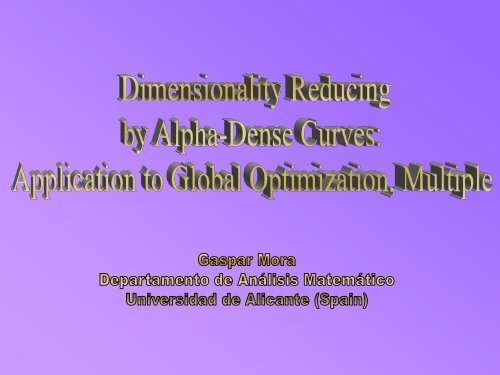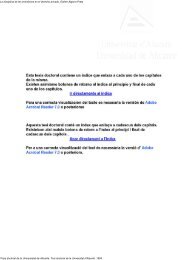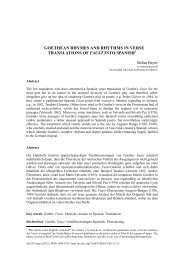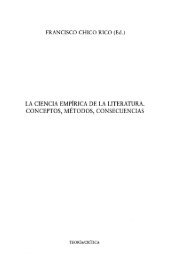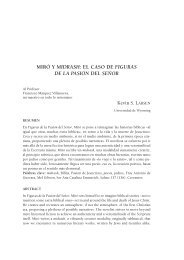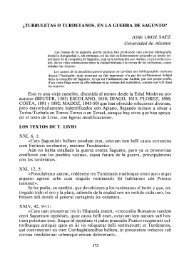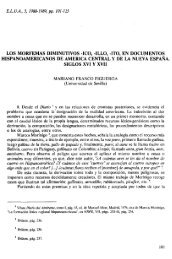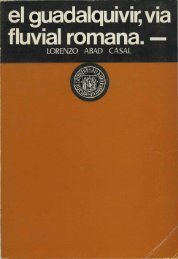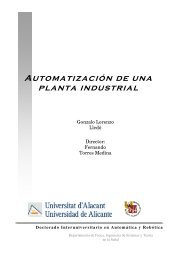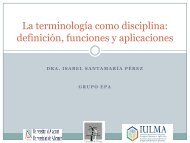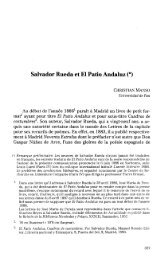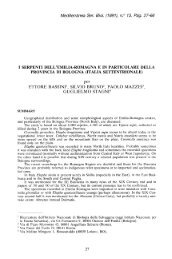Dimensionality Reducing by Alpha-Dense Curves ... - RUA
Dimensionality Reducing by Alpha-Dense Curves ... - RUA
Dimensionality Reducing by Alpha-Dense Curves ... - RUA
Create successful ePaper yourself
Turn your PDF publications into a flip-book with our unique Google optimized e-Paper software.
In Mathematics the word complexity, as synonym of difficulty, has not a clear<br />
meaning. However, it seems that it is very easy to understand that one<br />
mathematical problem involving functions of several variables is, in general,<br />
more complex than one problem with a univariable function. The <strong>Alpha</strong>-<strong>Dense</strong><br />
<strong>Curves</strong> theory tries to reduce the complexity associated to the dimension and<br />
establishes an Approximation Theory on the domains, in the sense of the<br />
Hausdorff metric, instead of that of the functions. Some applications to<br />
optimize multivariable continuous functions, to approximate a multiple<br />
integral <strong>by</strong> a simple one, and to determine if a non-linear inequality has<br />
solution, will be the subjects which we shall deal with techniques based on<br />
<strong>Alpha</strong>-<strong>Dense</strong> <strong>Curves</strong>.
Definition<br />
Given a real number ��0 , an � -dense curve (or curve of density � ) in a subset<br />
K of finite diameter in a metric space (E,d), is a continuous mapping<br />
whose image , now on denoted , is contained in K and the distance,<br />
, for any<br />
In others words, an � -<strong>Dense</strong> Curve in a compact set K is a Peano Continuum (a<br />
connected, locally connected and compact set) whose Hausdorff distance from K<br />
When �=0, one has a Peano curve (also called space-filling curve) provided that<br />
the interior of K, it follows that if a curve � is �-dense in K, then it is also �dense<br />
for any � >�. Thus the minimal � verifying the properties<br />
is, strictly speaking, the density of the curve in K , which coincides with the<br />
Hausdorff distance
Example<br />
In the euclidean space , N�2 for each positive integer m , the unit cube is densified<br />
<strong>by</strong> the curve defined <strong>by</strong><br />
It is easy to check that has density in where is a positive<br />
constant depending on N. For instance,<br />
Therefore their densities go to 0 as m�� .<br />
The curve is said to be the Cosines Curve of order m .
Example In , N�2 , for each positive integer m the unit cube is densified <strong>by</strong> the<br />
polynomial curve defined <strong>by</strong><br />
where is the Che<strong>by</strong>shev polynomial of the first kind of degree j , that is,<br />
The density of in the unit cube is ,where �(N) is a positive constant that<br />
depends on N (for instance, , etc.). Hence, also the densities tend to 0 as m�� .<br />
The curve is called the Che<strong>by</strong>shev Curve of order m .
Definition A subset K of (E,d) is said to be densifiable if it contains � -dense curves<br />
for arbitrary � >0 .<br />
As we just have seen, the unit cube is a densifiable set. This set has been densified <strong>by</strong> the<br />
Cosines and the Che<strong>by</strong>shev <strong>Curves</strong>. Now, taking into account the transformation<br />
, ,..., ,..., defined <strong>by</strong><br />
an � -dense curve in is transformed on a �-dense curve in the cube ,<br />
where<br />
Consequently, any cube is densifiable. Furthermore, as a cube is a Peano<br />
Continuum, the Hahn-Mazurkiewicz theorem implies that it is a continuous image of I.<br />
Hence any cube is in fact a Space-Filling Curve and so is, in particular, densifiable.<br />
Clearly, in a metric space (E,d) , the class of all densifiable sets contains the class of<br />
all Peano Continua . However, both classes are distinct. For instance, the set<br />
is densifiable but it is not a Peano Continuum, as it is well-known.
2.1.Convergence.<br />
As we know, given a real function f and a nonvoid set X , an usual form to present an<br />
Optimization Problem (O.P) is to find, or to approximate to, the value (finite or infinite)<br />
The function f is called the objective function and X the feasible set. Even for a differentiable<br />
objective function on a compact feasible set of the type in , , ,the<br />
minimization methods are not very efficient when N is large. Many problems, closely connected<br />
with the location of the global minimum, occur.These difficulties, in general, decrease when the<br />
objective function f is univariable. Thus, for f continuous on K , the multivariable optimization<br />
problem<br />
is substituted <strong>by</strong> the univariable one<br />
where and is an �-dense curve in K .<br />
The reduction of problem 1 to 2 has an error that we can estimate:<br />
Given a densifiable set K , let us denote <strong>by</strong> the class of all curves in K of density � .<br />
(2)<br />
(1)
Thus, for a given , the error in the approximation is<br />
Observe that since , always is . Furthermore,<br />
if and only if the �-dense curve passes through one global minimizer , i.e., a point<br />
where f attains the global minimum.<br />
An estimation of the error is given in the following result<br />
Theorem<br />
For each �-dense curve , the error is bounded where<br />
and is the modulus of continuity of f of order � .<br />
As corollary of the preceding theorem, the convergence of this reductional method is<br />
guaranted <strong>by</strong> the fact that the modulus of continuity tends to 0 as � goes to 0 .<br />
Whenever f is Lipschitzian, that is, it satisfies<br />
with 0
2.2.Minimization-Preserving Operators (M.P.O.).<br />
When we apply the �-<strong>Dense</strong> <strong>Curves</strong> method to the multivariable optimization problem<br />
we substitute (1) <strong>by</strong> the univariable one<br />
being , and is an � -dense curve in K .<br />
Then the new objective function will have, possibly, those extreme points (local and<br />
global extrema) that corresponding to f added to the points for which the gradient vector of<br />
f (if there exists) is orthogonal to the tangent vector to . For instance, if K is a cube<br />
always we can take with tangent vector nonnull for all t. That is, speaking in a<br />
colloquial language, we could say that the substitution of problem (1) <strong>by</strong> problem (2), can<br />
introduce "noise" due to the many extrema of .<br />
To eliminate this "noise" we introduced a type of operators that we called Optimization-<br />
Preserving Operators (Mora, Cherruault and Benabidallah, 2003). Later, these operators<br />
were studied from the specific role devoted to minimization and then they were called<br />
Minimization-Preserving Operators (M.P.O.) (Mora, 2005).<br />
(1)
Definition<br />
Let , be the spaces of continuous and bounded real functions , respectively on<br />
. and a subset of .We say that a mapping , , is a<br />
Minimization-Preserving Operator if and only if for any ,<br />
i) the minimizer set of , denoted , is contained in the minimizer set of g, denoted ,<br />
ii) and have at least a global minimum in common to both functions and g<br />
Trivial examples of minimization-preserving operators in are:<br />
a) The exponential operator,<br />
b) The dilation operator, with. real numbers<br />
In general, any strictly increasing function defines a M.P.O. on the space <strong>by</strong><br />
means of the composition law, that is, , for .<br />
.
Observe that in all the above examples , for all . In this case, these operators will<br />
be called trivial . Nevertheless, our objective is for defining a M.P.O. T such that be strictly<br />
included in for some functions g , such as the following example shows (Mora, 2005).<br />
Example<br />
Each arbitrary function �>0 continuous on I, defines a nontrivial M.P.O. T on <strong>by</strong> the<br />
formula<br />
where is a global minimizer of g ( for instance, can be chosen as the minimum, in I , of<br />
all the global minimizers).<br />
The main results to reduce the mentioned noise are the following (Mora, 2005).
Theorem<br />
Let A be an arbitrary constant, the Heaviside function and an arbitrary<br />
bijective function of class with . Let M be positive, consider the numbers:<br />
Thus, for each the formula<br />
and<br />
for any x� I and arbitrary , defines an M.P.O. on the closed ball<br />
on the space . Furthermore<br />
i) in the level set , constant,<br />
ii) all the minimizers, nonnull, of are in the level set .
The reiterated application of the above theorem generates a procedure for finding a global<br />
minimizer, as we can see in the next result.<br />
Corollary<br />
Under the hypotheses of the above theorem and reiterating its application, for<br />
each , with a set of minimizers proper and finite, we obtain an<br />
algorithm to find a global minimizer of g.
Now, our purpose is to reduce directly the integral of a non-negative real function f, of class on the<br />
unit cube , , to a simple one on the interval [-1,1]. For that, we shall use an �-<strong>Dense</strong><br />
Curve that densifies with arbitrary small density each elementary cube of the region of quadrature.<br />
The key of the result that we are looking for is in the following facts:<br />
1) For any c>0 , the cube is densified <strong>by</strong> the Cosines Curve, that is, <strong>by</strong> the curve<br />
defined <strong>by</strong><br />
2) The volume of can be calculated <strong>by</strong> the formula<br />
where is the length of given <strong>by</strong> the integral where<br />
is the tangent vector.<br />
Now, the dimension of the integral is reduced <strong>by</strong> means of the following result (Mora and Mora-Porta,<br />
2005).
Theorem<br />
Let f be a real non-negative function of class on and the Cosines Curve of order m in<br />
. Thus the integral<br />
may be approximated, for large enough m, <strong>by</strong><br />
where is the Che<strong>by</strong>shev polynomial of the second kind of degree and .<br />
Analogously, if each elementary cube of the region of quadrature<br />
<strong>by</strong> a Che<strong>by</strong>shev Curve<br />
, , is densified<br />
with<br />
one has the following result (Mora, Benavent and Navarro, 2002).
Theorem<br />
Let f be a real nonnegative function of class on and the Che<strong>by</strong>shev Curve of<br />
order m in .Thus the multiple integral<br />
can be approximated, for large enough m, <strong>by</strong> the simple integral<br />
where is de Che<strong>by</strong>shev polynomial of the second kind of degree and<br />
If we denote <strong>by</strong> the error in the approximation to the multiple integral of f <strong>by</strong> using the<br />
Cosines Curve, one has<br />
An estimation of is given in the following result (Mora and Mora-Porta, 2005).<br />
Theorem For the Cosines Curve of order m in the unit cube , the error in the integral<br />
reduction formula is an .<br />
Remark The constant in depends on the 1-norm of f defined <strong>by</strong><br />
where is the gradient of f .<br />
For the Che<strong>by</strong>shev Curve we think that it would have a similar result.
Given a real function f defined on a densifiable compact set K of a metric space (E,d), it is<br />
crucial in many applications, to know the set (possibly empty)<br />
An �-<strong>Dense</strong> <strong>Curves</strong> approach to this problem would be:<br />
1) Let us take an �-dense curve in K, �, which without loss of generality we can suppose<br />
nonconstant on any subinterval of I. Furthermore we can also suppose the existence of an<br />
increasing bijective function , only continuous at 0, and satisfying<br />
2) Define on I the univariable function , and for each s such that<br />
consider the number<br />
where is the open ball centered at and radius r .<br />
Taking into account the above considerations, one has the following result (Mora,<br />
Cherruault and Ubeda, 2005).
Theorem Let K be a densifiable compact of a metric space (E,d) , � an � -dense<br />
curve in K (satisfying the preceding assumptions 1,2) and f a real function defined on K ,<br />
continuous on . Then, on the set , the recursive sequence<br />
. ( ) defined <strong>by</strong><br />
satisfies:<br />
i) If for some , then either or .<br />
ii) If for all , , then the sequence converges to<br />
some .<br />
When the hypothesis of the continuity of f on the � -dense curve � is extended to the<br />
whole K, we have the following result.<br />
Corollary<br />
Let be a sequence of -dense curves in K, with as . Under the<br />
same hypotheses of the above theorem and adding the continuity of f on K, assume that for<br />
each curve there is a positive integer such that the corresponding recursive<br />
sequence . Then the set<br />
where is the set of all zeros of f .
<strong>Alpha</strong>-<strong>Dense</strong> <strong>Curves</strong> method has been applied to minimize, to integrate and to solve inequalities<br />
involving functions of a great number of variables. These functions appear when we model some<br />
processes where the experiments are not possible ,difficult or very expensive. The private enterprises<br />
that have supported research on this theory and its applications at the Laboratoire MEDIMAT de<br />
l'Université Pierre et Marie Curie, Paris VI (France) are:<br />
– Renault,<br />
– DGA,<br />
– Pharmaceutical Laboratories: Boiron, Servier and Sandoz,<br />
– Banking Sector: Crédit Agricole.
The main concrete problems which have been studied following this method were:<br />
1. Degranulation of Basophyls, Visual Perception for Artificial Perception.<br />
2. Study on the gluclose-insuline system (a preliminar study on the conception of an<br />
artificial pancreas).<br />
3. Study of the Pelagic Ecosystem of an upwelling location.<br />
4. Competition model between two different cultures and diffussion microbes in<br />
water.<br />
5. Industrial process for clarifying apple juice.<br />
6. Difussion of Streptadivin and DTPA-Biotin in inmmunoscintigraphy of heart in<br />
two stages.<br />
7. Determination of temperature in the interior of oil wells.<br />
8. Analysis of stocks corresponding to agricultural and food products.<br />
9. Models of the combustion <strong>by</strong> hydrogen, reduction of pollution and comfortability<br />
of cars.<br />
10.Dispersion of materials in blood plasma.<br />
11.Transport of anticancer substances applied to the brain surface.<br />
12.The Nitroarginine and the problem of inhibition of the NOsynthase.<br />
In the U.N.T. and the U.A. (Spain), we are applying the � -<strong>Dense</strong> <strong>Curves</strong> method to<br />
parameter estimation of transition-time probability density in forest models.
The �-<strong>Dense</strong> <strong>Curves</strong> as mathematical theory is of interest in itself and has links with other<br />
subjects.<br />
6.1. Peano <strong>Curves</strong>.<br />
In 1890, G.Peano demonstrated that the interval I=[0,1] could be mapped surjectively and<br />
continuously onto the square .These curves are called Peano <strong>Curves</strong> or also<br />
Space-filling <strong>Curves</strong>. Some of them are famous such as that of Hilbert (1891),Moore (1900)<br />
and Lebesgue (1904). However a general method for generating these curves remained<br />
unsettled.<br />
H.Steinhaus in 1936 solved the problem <strong>by</strong> means of a surpresively result :<br />
" if two continuous non-constant functions on I are stochastically independent with respect<br />
to Lebesgue measure, then they are the coordinate functions of a space-filling curve " .<br />
We have proved that the condition of stochastically independence (s.i.) is too strong to<br />
characterize space-filling curves. We pointed out that there are space-filling curves whose<br />
coordinate functions are not s.i. Indeed (Mora,G. and Mira,J.A., 2001),<br />
The coordinate functions of the Lebesgue curve are not stochastically independent.<br />
For the purpose to characterize the Space-Filling <strong>Curves</strong> we introduced a filling condition<br />
(f.c.) in terms of the quasi-stochastically independent concept.
Definition (Filling condition )<br />
We shall say that N measurable functions ,..., are quasi-stochastically<br />
independent (q.s.i.), with respect to the Lebesgue measure on R (denoted ) , if for any open sets<br />
. of R the condition<br />
implies<br />
Using this filling condition or q.s.i. concept, we obtained a characterization of space-filling curves<br />
<strong>by</strong> means of the following results (Mora,G. and Mira,J.A., 2001):<br />
Theorem Let ,..., be quasi-stochastically independent functions ( r.L.m.). Assume<br />
also that they are continuous and nonconstant.Thus the curve defined <strong>by</strong> ,...,<br />
fills the parallelepiped .<br />
Conversely<br />
Theorem<br />
Let ,..., be nonconstant continuous functions such that the curve ,...,<br />
fills the parallelepiped Thus ,..., are quasi-stochastically independent (r.L.m).<br />
In fact, the idea of filling condition was already, implicitly, handled when we gave a<br />
characterization of �-dense curves in parallelepipeds of (Mora,G. and Cherruault, 1997).<br />
We also settled a characterization theorem on the filling condition in terms of Borel measures.<br />
Moreover, this result yields a method to construct the coordinate functions of a space-filling curve<br />
(Mora,G. and Mira,J.A., 2001).
Theorem Assume are Q.S.I continuous nonconstant functions and<br />
H .Then the set function<br />
on the class of all cubes contained in H , defines a Borel measure for which<br />
Reciprocally, any Borel measure � on a parallelepiped<br />
satisfying (1) defines N continuous nonconstant functions that are Q.S.I.<br />
We recently gave a characterization of the space-filling curves <strong>by</strong> uniform limits of �dense<br />
curves in the compact that is filled.The �-dense curves must have densities tending<br />
to zero and coordinate functions with variation tending to infinity as � tends to zero<br />
(Mora, 2005).<br />
More precisely, the result is.<br />
Theorem<br />
A continuous mapping is a Peano curve filling if and only � if is the<br />
uniform limit of a sequence of �-dense curves in with densities ,<br />
for which there is no constant M such that the variation , for all n, for some .
6.2. �-<strong>Dense</strong> <strong>Curves</strong> of the Minimal Length.<br />
In a densifiable compact K of a metric space (E,d), the existence of an �-dense curve, for fixed<br />
�>0, with a minimal length, has been solved. We have used the set<br />
that is, the set of all �, �-dense in K, satisfying<br />
for some and .<br />
When the set will be denoted , and we shall consider that as a subset of<br />
the space of all continuous mappings on I and valued in E, endowed with the metric<br />
Because of the Ascoli's theorem, the compactness of is proved in the following result.<br />
Lemma<br />
Let (E,d) be a metric space and K a densifiable compact. Then, is a compact in the space<br />
. for the metric .<br />
Now, the existence of �-dense curves with minimal length follows (Ziadi,Cherruault and<br />
Mora, 2000).<br />
Theorem<br />
Let K be a densifiable compact of a metric space (E,d) and the set of all � -dense<br />
curves in K, �>0. Assume contains at least a rectifiable curve, thus there exists<br />
such that<br />
,where is the length of � .
6.3.Functional equations generating �-dense curves.<br />
A surpresive connection between �-dense curves and functional equations emerged when we<br />
were trying to solve one of these. Such is the case, for instance, of the functional equations<br />
and<br />
whose continuous solutions can densify, with arbitary small density, compacts of the plane. Indeed,<br />
in this manner we have proved the following results.(Mora, Cherruault and Ziadi,2000)<br />
Theorem Let p
Open problem with respect to the functional equations and �-<strong>Dense</strong> <strong>Curves</strong>.<br />
We have just seen how special compacts have been densified <strong>by</strong> continuous solutions of the<br />
preceding functional equations. Then, except traslation and dilation of the compact set, our<br />
problem is:<br />
Problem<br />
In , given a densifiable compact K having <strong>by</strong> boundary a path, is there a functional<br />
equation such that its continuous solutions can densify it ?<br />
6.4. The �-<strong>Dense</strong> <strong>Curves</strong> in Topological Vector Spaces.<br />
Whenever E is a topological vector space,not necessarily metrizable, the concept of �-density<br />
is substituted <strong>by</strong> that of the V-localization, V being a given 0-neighborhood. This concept is<br />
formalized <strong>by</strong> means of the following definition.<br />
Definition<br />
We say that a subset B of a topological vector space is V-localized <strong>by</strong> a curve, i.e., <strong>by</strong><br />
a continuous mapping, , if and only if
Definition A subset B of a topological vector space is said to be localizable if and only<br />
if is V-localized <strong>by</strong> any 0-neighborhood V.<br />
A nontrivial example of localizable set in a nonmetrizable topological vector space is given in<br />
the following result. (Mora, 2005):<br />
The space, or briefly , of all real measurable (Lebesgue) functions on satisfying<br />
endowed with the weak topology , is not metrizable. In this space , the probability<br />
functions set<br />
where , is localizable.<br />
For the Banach spaces we have the following result about the localization concept and the<br />
dimensionality (G.Mora & J.A. Mira, 2003).<br />
Theorem<br />
In a Banach space E , the unit ball is localizable if and only if E is finite-dimensional.<br />
Let E be a normed space and B its unit ball. Each curve � in B , has a density (minimal)<br />
given <strong>by</strong><br />
where denotes and is the metric induced <strong>by</strong> the norm.<br />
Then, considering the set of all curves contained in B, denoted , we can define the degree<br />
of densificability of B as the number
Observe that for any normed space<br />
and, from the preceding theorem, in a Banach space, if and only if the space has<br />
finite dimension.Then if the space has infinite dimension it follows that . Now, a<br />
natural question is:<br />
does it exist a normed space for each value between 0 and 1?<br />
The answer is given <strong>by</strong> the following result (Mora and Mira, 2003).<br />
Theorem<br />
For any normed space, the degree of densificability of its unit ball can take exactly two<br />
values, either 0 or 1.<br />
Now, we obtain a well-known classical theorem as corollary the Riesz theorem on the<br />
dimension:<br />
Corollary<br />
Any normed space locally compact is finite dimensional.
1. Cheney, E.W., Introduction to Approximation Theory, Chelsea Publ. Company,<br />
New York, 1982.<br />
2. Cherruault,Y. and Mora,G.,Optimisation Globale. Theorie des Courbes �-<br />
<strong>Dense</strong>s, Economica, Paris, 2005.<br />
3. Choquet,G., Cours D'Analyse-Topologie, Masson et Cie, Paris, 1971.<br />
4. Cichon, J. and M. Morayne, M., On Differentiability of Peano Type Functions III,<br />
Proc. Am. Math. Soc. , 92 , (1984), 432-438.<br />
5. Davis, P.J., Interpolation and Approximation, Dover, New York, 1975.<br />
6. Hahn, H. , Über stetige Streckenbilder, Atti del Congreso Internazionale dei<br />
Mathematici, Bologna, 3-10 September, VI, (1928), 217-220.<br />
7. He, T.X., <strong>Dimensionality</strong> <strong>Reducing</strong> Expansion of Multivariable Integration,<br />
Birkhäuser, Boston,2001.<br />
8. Hilbert, D., Über die stetige Abbildung einer Linie auf ein Flächenstück, Math.<br />
Annln.38, (1891), 459-460. Holbrook, J.A., Stochastic independence and spacefilling<br />
curves, Amer, Math. Monthly, 88, (6) ,(1981), 426-432.<br />
9. Kelley, J.L., General Topology, D. Van Nostrand, New York,1955.<br />
10. Köthe,G., Topological Vector Spaces I, Springer-Verlag, Berlin,1969.
11. Kharazishvili, A.B., Strange Functions in Real Analysis, Dekker,New York, 2000.<br />
12. Lebesgue, H., Leçons sur L'intégration et la Recherche des Fonctions Primitives,<br />
Gauthier-Villars, Paris, 1904.<br />
13. Lebesgue, H., Sur les fonctions représentables analytiquement, J.de Math., 6 , 1<br />
(1905), 139-216.<br />
14. Mazurkiewicz, St., Travaux de Topologie et ses Applications, PWN-Polish Scientific<br />
Publishers, Warszawa, 1969.<br />
15. Moore, E.H., ON certain crinkly curves, Trans. Amer. Math. Soc., 1, 72-90, (1900).<br />
16. Mora,G., and Cherruault,Y., Characterization and Generation of �-<strong>Dense</strong> <strong>Curves</strong>,<br />
Computers Math. Applic. Vol.33 No.9(1997), 83-91.<br />
17. Mora, G. and Cherruault ,Y., The Theoretical Calculation Time associated to �-<br />
<strong>Dense</strong> <strong>Curves</strong>, Kybernetes, Vol. 27, No.8, (1998), 919-939.<br />
18. Mora, G.and Cherruault, Y., An approximation method for the optimization of<br />
continuous functions of variables <strong>by</strong> densifying their domains, Kybernetes, 28, 2<br />
(1999), 164-180.<br />
19. Mora, G. and Cherruault, Y., On the minimal length curve that densifies the square,<br />
Kybernetes, 28 , 9(1999), 1054-1064.<br />
20. Mora, G. , Optimization <strong>by</strong> space-densifying curves as a natural generalization of<br />
the Alienor method, kybernetes,Vol. 29, No.5/6, (2000), 746-754.<br />
21. Mora, G., Cherruault, Y. and Ziadi, A., Functional equations generating spacedensifying<br />
curves, Computers and Math. with Applic., 39, (2000) , 45-55.
22. Mora,G. and Mira, J.A., A characterization of space-filling curves, Rev. R. Acad.<br />
Cien. Serie A. Mat. , Vol. 96 No.1,(2001), 45-54.<br />
23. Mora, G., Cherruault, Y., Benabidallah, A. and Tourbier, Y., Approximating<br />
Multiple Integrals via �-<strong>Dense</strong> <strong>Curves</strong>, Kybernetes, Vol. 31 No.2 (2002), 292-<br />
304.<br />
24. Mora, G., Benavent, R. and Navarro, J.C., Polynomial <strong>Alpha</strong>-<strong>Dense</strong> <strong>Curves</strong> and<br />
Multiple Integration, Inter. Journal of Comput. and Num. Anal. and Applic., Vol. 1<br />
No.1 (2002), 55-68.<br />
25. Mora, G, Cherruault, Y and Benabidallah, A. , Global Optimization-Preserving<br />
Operators, Kybernetes, Vol. 32, No.9/10, (2003), 1473-1480.<br />
26. Mora,G. and Mira,J.A., <strong>Alpha</strong>-<strong>Dense</strong> <strong>Curves</strong> in Infinite Dimensional Spaces,<br />
Inter. Journal of Pure and Applied Math. Vol.5, No.4 (2003), 437-449.<br />
27. Mora,G., Cherruault,Y. and Ubeda,J.I., Solving Inequalities <strong>by</strong> �-<strong>Dense</strong> <strong>Curves</strong>.<br />
Application to Global Optimization, Kybernetes, Vol.34, No. 7/8, (2005), 983-991.<br />
28. Mora,G. and Mora-Porta,G., <strong>Dimensionality</strong> <strong>Reducing</strong> Multiple Integrals <strong>by</strong><br />
<strong>Alpha</strong>-<strong>Dense</strong> <strong>Curves</strong>, Inter. Journal of Pure and Applied Math., Vol.22,No.1,<br />
(2005), 105-116.<br />
29. Mora,G., The Peano <strong>Curves</strong> as Limit of �-<strong>Dense</strong> <strong>Curves</strong>, RACSAM, Vol.99 (1),<br />
(2005), 23-28.
30. Mora,G., Minimizing Multivariable Functions <strong>by</strong> Minimization-Preserving<br />
Operators, Mediterr. J. Math. 2 (2005), 315-325.<br />
31. Morayne,M. , On Differentiability of Peano Type Functions, Colloquium<br />
Mathematicum, LIII, (1987),129-132.<br />
32. Morayne, M., On Differentiability of Peano Type Functions II, Colloquium<br />
Mathematicum, LIII, (1987),133-135.<br />
33. Natanson, I.P. , Theory of Functions of a Real Variable, Vol. I , II, Frederick<br />
Ungar Publishing Co., New York , 1964.<br />
34. Peano, G., Sur une courbe qui remplit toute une aire plaine, Math. Annln., 36,<br />
(1890), 157-160.<br />
35. Sagan,H., Space-Filling <strong>Curves</strong>, Springer-Verlag, New-York, 1994.<br />
36. Robertson,A.P. and Robertson,W.J., Topological Vector Spaces, Cambridge<br />
University Press, Cambridge, 1973.<br />
37. Steinhaus, H., La courbe de Peano et les fonctions indépendantes, C. R. Acad. Sci.<br />
Paris 202, 1961-1963 (1936).<br />
38. Tricot, C. , <strong>Curves</strong> and Fractal Dimension , Springer-Verlag , New York, 1995.


